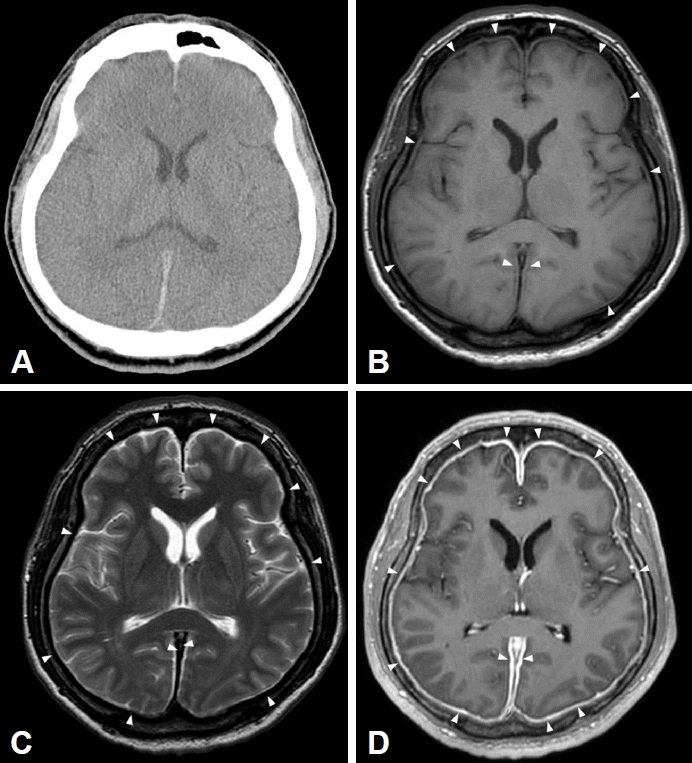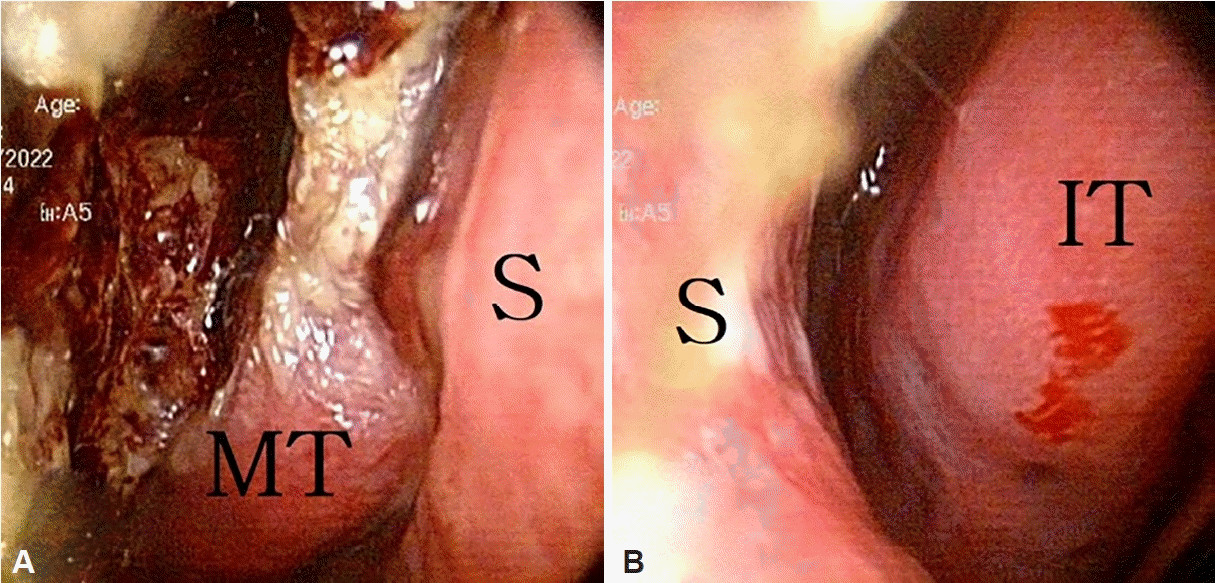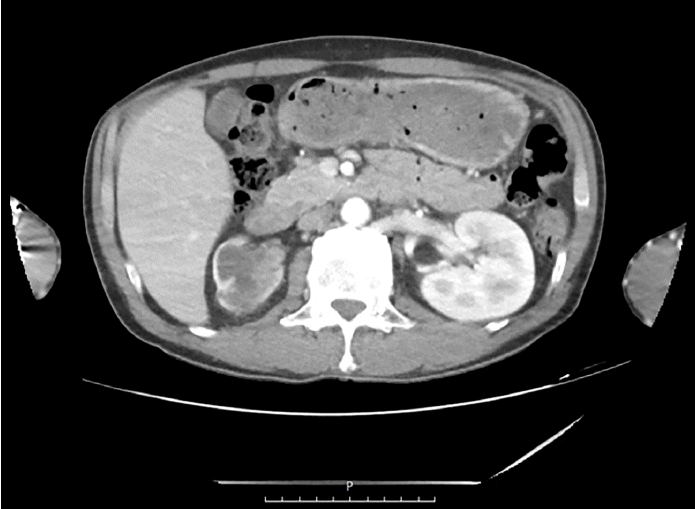This article has been
cited by other articles in ScienceCentral.
Abstract
IgG4-related disease (IgG4-RD) is a systemic inflammatory disease characterized by IgG4-positive plasma cell and T lymphocyte infiltration of multiple organs. It commonly involves the pancreas, lacrimal glands, and salivary glands, and it has been rarely reported in the sinonasal cavity. We herein report the case of a 47-year-old male patient whose chief complaint was decreased visual acuity. A tumefactive mass was found on imaging studies, originating from the sinonasal cavity and invading the orbit, kidney, and meninges. The mass was resected through endoscopic sinus surgery and was pathologically confirmed to be IgG4-RD. The patient was treated with steroid therapy and showed clinical improvement.
Keywords: Immunoglobulin G, Immunoglobulin G4-Related Disease, Paranasal Sinuses, Glucocorticoid
INTRODUCTION
IgG4-related disease (IgG4-RD) is a tumefactive progressive immune disease that invades multiple organs [
1]. It was first described in 2001, when elevated serum IgG4 concentrations were found in patients with autoimmune pancreatitis [
2]. In the head and neck area, IgG4-RD mainly invades the orbit, lacrimal glands, and lymph nodes. In rare cases, it invades the thyroid gland and appears as Riedel’s thyroiditis, and cases involving paranasal sinuses are scarce [
3]. Beyond the head and neck, IgG4-RD can also involve various other organs, including the retroperitoneum, mediastinum, central nervous system, breast, kidney, prostate, and lung [
4]. The clinical symptoms of IgG4-RD can manifest in various ways depending on the organ involved, and its characteristic histopathological findings are the cornerstone of the diagnosis.
We report a rare case of IgG4-RD with sinonasal involvement that was diagnosed through endoscopic sinus surgery and successfully treated by glucocorticoid therapy. The relevant literature was also reviewed.
CASE REPORT
A 47-year-old male patient visited the emergency department with impaired vision on both sides for 10 days. He also complained of a right frontal headache that had lasted for 7 days and recurrent epistaxis since 3 years ago. At the time of the visit to the hospital, there was no epistaxis, but the patient complained of dry nose and purulent rhinorrhea from the right side. The patient had no specific medical history other than hypertension. His vital signs were normal.
On an ophthalmologic examination, the patient’s visual acuity was oculus dexter (OD) 20/120 and oculus sinister (OS) hand motion, and extraocular muscle movement was normal, as shown in an image that was taken with the consent of the patient (
Fig. 1). Bilateral papilledema was identified on a fundus examination. Non-contrast brain computed tomography showed no definite abnormality. Brain magnetic resonance imaging showed diffuse pachymeningeal enhancement along both the cerebral and cerebellar hemispheres (
Fig. 2). In the cerebrospinal fluid analysis, the pressure was raised to 38 mm H2O, the white blood cell count was 5/mm3, viral antigen testing was negative, and no bacterial pathogens were isolated. Peripheral blood tests showed an elevated white blood cell count (12.07 × 10
9/L; normal range, 4.0–10.0 × 10
9/L), erythrocyte sedimentation rate (72 mm/h; normal range, 10–15 mm/h), C-reactive protein (35.78 mg/L; normal range, 0–5 mg/L). On orbital magnetic resonance imaging, the right maxillary, ethmoid, and frontal sinus were filled with areas of soft tissue density, and a 2.5 × 1.2×3.1-cm mass with contrast enhancement was found in the medial and inferior sides of the right orbit, causing bone destruction through the ethmoid sinus. Nasal endoscopy showed a severe crust on the right lateral nasal wall and middle meatus, diffuse mucosal edema, and mucopurulent discharge (
Fig. 3). The bacterial culture of the nasal discharge showed growth of
Klebsiella pneumoniae. The fungal culture and acid-fast bacilli smear were negative.
Based on the invasive growth of the mass and elevated levels of inflammation markers, we performed endoscopic sinus surgery under the suspicion of a malignant sinus tumor or fungal sinusitis. The main aim of surgery was to obtain a biopsy and allow orbital decompression. During surgery, the maxillary, ethmoid, and frontal sinus openings were obstructed by the mass. Dehiscence of the lamina papyracea was found after removing the mass occupying the ethmoidal sinus, and the extraocular muscles were not damaged during the process. The mass invading the maxillary and frontal sinus was partially resected. The intraoperative frozen section diagnosis was suggestive of fibrous tissue rather than malignancy. The definitive tissue pathology showed more than 120 IgG4-positive plasma cells per high-power field (×200), a ratio of IgG4-positive plasma cells to IgG-positive plasma cells of 50%, storiform fibrosis, and obliterative phlebitis; these findings were strongly suggestive of IgG4-RD (
Fig. 4).
Abdominal computed tomography and chest computed tomography were performed to evaluate involvement of IgG4-RD elsewhere than the sinus. Chest computed tomography was normal, but abdominal computed tomography showed multiple low-density opacities in the right renal parenchyma, suggesting IgG4-related renal disease (
Fig. 5). The serum IgG level was normal (1,234 mg/dL; normal range, 700–1,600 mg/dL), while the IgG4 level showed mild elevation (98.9 mg/dL; normal range, 3.9–86.4 mg/dL). Autoimmune serum markers showed weak positivity for cytoplasmic antineutrophil cytoplasmic antibodies (1:20; normal range, <1:20) and negative results for other markers, including antineutrophil antibodies and perinuclear antineutrophil cytoplasmic antibodies.
We diagnosed the patient with IgG4-RD according to the diagnostic criteria of IgG4-RD revised in May 2020 [
5].
Subsequently, an intravenous steroid (methylprednisolone, 1 g/day for 3 days) and an oral steroid (prednisolone, 40 mg/day for 3 weeks, 30 mg/day for 1 week, and 25 mg/day for 2 weeks thereafter) were administered. From the second week of steroid administration, the headache and visual impairment began to improve subjectively. After 6 weeks of steroid administration, the headache was resolved and the decreased visual acuity of the right eye had improved, while visual impairment of the left eye persisted (OD 20/40, OS hand motion). Follow-up nasal endoscopy demonstrated no recurrence of the lesion. Currently, the patient is on maintenance glucocorticoid therapy.
DISCUSSION
Several immunologic responses contribute to the pathophysiology of IgG4-RD, which can be triggered by factors such as human leukocyte antigen serotype [
6], and
Helicobacter pylori infection [
7,
8]. The immune mechanism consists of type 2 helper T cell reactions that show overexpression of the interleukin (IL)-4, IL-5, IL-10, and IL-13 cytokines, and regulatory T cell reactions that show overexpression of IL-10 and transforming growth factor-beta [
9].
The initial diagnostic criteria for IgG4-RD were established in 2011, and the 2020 revision is different, since it includes organ-specific criteria. The diagnostic criteria are as follows. First, clinically and radiologically, one or more organs show diffuse or localized swelling or a mass or nodule characteristic of IgG4-RD. Second, the serum IgG4 level is greater than 135 mg/dL. Third, positivity for two of the following three criteria is met in the pathological diagnosis: 1) dense lymphocyte and plasma cell infiltration with fibrosis, 2) a ratio of IgG4-positive plasma cells/IgG-positive cells greater than 40% and more than 10 IgG4-positive plasma cells observed per high-power field, and 3) typical tissue fibrosis, particularly storiform fibrosis, or obliterative phlebitis. Even if only two of the three diagnostic criteria are satisfied, a patient can be diagnosed with definitive IgG4-RD if the organ-specific diagnostic criterion is satisfied.
The patient presented herein satisfied the 2020 revised diagnostic criteria for IgG4-RD, based on histological results and abdominal computed tomography demonstrating IgG4-related renal disease [
10], although the serological criterion was not satisfied. In addition, diffuse contrast enhancement and thickening of the pachymeninges on brain magnetic resonance imaging and elevated intracranial pressure suggested IgG4-RD affecting the meninges. According to Lindstrom et al. [
11], IgG4-RD was diagnosed histologically in five out of 10 subjects with idiopathic pachymeningeal thickening, which could be viewed as a characteristic suggestive of IgG4-RD.
For most symptomatic IgG4-RD patients, prednisolone monotherapy is initially recommended. It is common to perform induction therapy with prednisolone or prednisone for about 3 to 4 weeks, and slowly taper to low-dose maintenance therapy [
12]. Although no definitive agreement has been reached on the treatment of IgG4-RD with sinonasal involvement, according to Ueno et al. [
13], four out of five cases of IgG4-RD with sinus invasion showed improvement of nasal congestion and computed tomography findings following the administration of prednisolone at a dose of 0.5–0.6 mg/kg/day. A case was also reported where the administration of a corticosteroid nasal spray improved nasal congestion. In addition to glucocorticoids, traditional immunosuppressants (e.g., azathioprine and methotrexate), biologic agents (e.g., rituximab), and surgery are options for the treatment of IgG4-RD. Several reports have stated that the combination of a glucocorticoid and the agents mentioned above had significant benefits beyond those of glucocorticoid monotherapy [
14].
In 2012, the IgG4-RD Responder index was published, which indicates disease activity and prognosis [
15]. Disease activity is scored on a scale of 0 to 4 points for sclerosis or mass formation of multiple organs. The index also includes the response to medications, reflecting serum IgG4 levels and the administered dose of glucocorticoids. It could be possible to evaluate the effects of glucocorticoids on the patient presented herein by tracking changes in serum IgG4 levels and evaluating the organs affected by IgG4-RD.
The patient described in this case report was diagnosed with IgG4-RD with sinonasal involvement, which has been rarely reported in the field of otolaryngology. Moreover, among the eight cases of IgG4-RD with sinonasal involvement published in Korea, this was the only patient who visited the hospital with the chief complaint of visual impairment. It is necessary to perform endoscopic or surgical biopsy under the suspicion of IgG4-RD when a mass-forming lesion in the paranasal sinuses and nasal cavity is found.







 PDF
PDF Citation
Citation Print
Print





 XML Download
XML Download